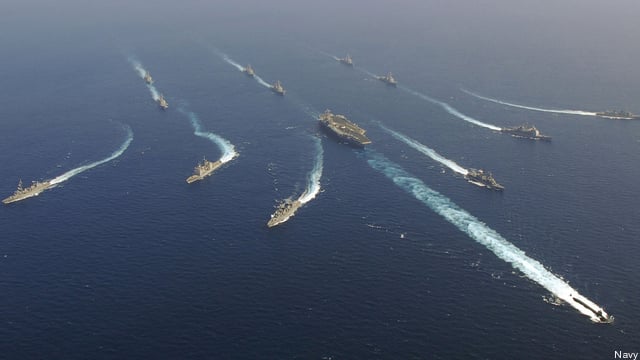HASC Seapower OKs New Carrier $, Boosts Oversight; CNO Replies
Posted on

[updated with Adm. Greenert comment] House Armed Services seapower chairman Randy Forbes promised a “rebirth” of oversight in my interview with him last week, and he makes a down payment on that in his subcommittee’s markup of the defense bill. It includes a host of new reporting and certification requirements.
Top of the deck comes the Navy’s over-budget aircraft carrier. The subcommittee grudgingly raises the cost cap on the immensely expensive USS Gerald Ford (CVN-78), the first of a new class intended to replace the venerable Nimitz and now expected to cost $12.9 billion.
Although Forbes does not punish the Navy in any way for it, the subcommittee mark does warn: “Continued [cost] escalation on the entirety of the ship construction accounts…is unsustainable.”
Here’s a rundown of the rest of the subcommittee’s draft bill. If these make it through the Senate version and conference, the Pentagon would have to
- Demonstrate that the X-47B drone, which just last week made its first launch from and first “touch and go” landing on an aircraft carrier, can refuel itself in mid-air from flying tankers just like a manned aircraft;
- Certify that software and system engineering for the X-47B’s combat-capable successor, the Unmanned Carrier-Launched Airborne Surveillance and Strike drone, are “at a low level of … risk” before proceeding with the UCLASS program;
- Keep retired KC-135R aerial refueling tankers flyable and ready to return to service until the new KC-46 enters service;
- Tell Congress whether the Navy’s mainstay destroyer, the DDG-51 Arleigh Burke class, can really keep being upgraded to accommodate a power-hungry new radar for missile defense (there’s an interesting suggestion that the radar might be installed instead aboard the roomier LPD-17 San Antonio-class amphibious warfare ships, built in Pascagoula; someone in Mississippi must be happy that provision made it in);
- Do a report on whether the Arleigh Burkes and other surface combatants can accommodate another high-energy technology, laser weapons (this may be a plug for the competing DDG-1000 Zumwalt class, which was cut off after three vessels because of its cost but which boasts far more electrical power)
The mark-up language would also require the Government Accountability Office (GAO), which is quite independent of the Pentagon, to report on two sensitive priorities:
- The status of the Marine Corps’s prized Amphibious Combat Vehicle (ACV), the replacement for the disastrously over-budget Expeditionary Fighting Vehicle cancelled in 2011;
- Whether the Navy’s current contracting structure, based on so-called “fixed-price incentive fee” (FPIF) contacts, is really reaping the savings it was intended to.
For all this, the mark places few constraints on any major programs. To the contrary, it adds money to protect a perennial favorite of both Congress and state governors, the C-130 Hercules cargo plane, adding $15.7 million for engine upgrades and $47.3 million for an avionics modernization program (called AMP) that the Pentagon had tried to cancel. (The oft-neglected full name of Forbes’ subcommittee is seapower and projection forces, which includes jurisdiction over the Air Force’s long-range bombers and airlift).
As for nine aging but still serviceable ships that the Navy wanted to retire to save on maintenance costs, Forbes’s press release said the full committee mark-up “is expected” to demand the Navy not only keep them but also pay for their modernization.
For the long term, the mark includes a requirement – which as of last week’s interview Forbes had still been unsure would make it into this year’s bill – that the Navy report to Congress on what kind of fleet they could actually afford if the shipbuilding budget stayed at its historical average of $16 billion a year. The Navy’s official 30-year shipbuilding plan instead assumes funding will spike in the outyears to a Reaganesque $19 billion. That plan Forbes is not alone in dismissing as a “fantasy.”
I had the opportunity to ask the Chief of Naval Operations, Adm. Jonathan Greenert, about this proposed reporting requirement at a question-and-answer session he held this evening. The Navy will certainly comply with whatever Congress directs, the CNO said. Under current law, he said, when the Navy presents its 30-year plan to Congress, “we certify that we have enough money in the year that we deliver the plan” — in other words, not for the full 30-year term, which to be frank is an awfully long way in the future for accurate forecasts.
“We look at very closely at what we have through the Future Years Defense Plan, the FYDP, and we feel very comfortable with those numbers,” Greenert went on. “When you get beyond the FYDP, you get into the 15 year, 20-year, certainly the 30-year, it becomes an extrapolation.”
If the Congress wants an alternative 30-year projection based on “constrained numbers,” Greenert said, “we can certainly do that, we have done it in the past, and we’ll comply with directed language.”
Updated 8:00 pm with remarks from Adm. Jonathan Greenert.
Subscribe to our newsletter
Promotions, new products and sales. Directly to your inbox.
